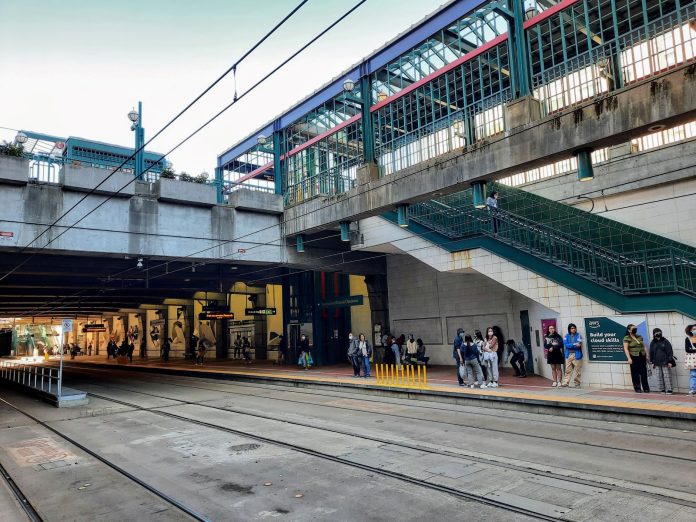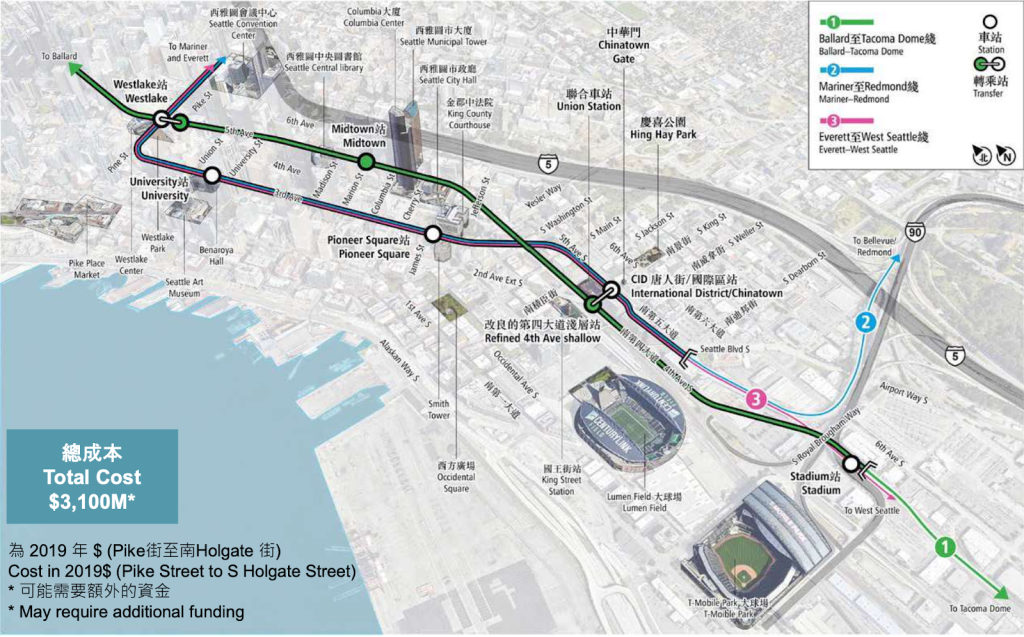
Savings could elevate light rail in Rainier Valley, speeding up service, improving safety, and fully automate the system.
Sound Transit is currently planning the West Seattle and Ballard Link Extensions (WSBLE), which would include a new Downtown Seattle Transit Tunnel running parallel to the existing one. This new tunnel would carry the Link light rail 1 Line from Tacoma to Ballard, connecting to other lines at International District/Chinatown and Westlake using new stations. But why dig a new Downtown transit tunnel when one already exists?
Sound Transit argues the new tunnel would provide needed capacity to carry more light rail trains. Under the proposed operation plan, all Link lines going Downtown would arrive with six-minute frequencies during peak commuting hours when the expansion is complete. The 1 Line (Tacoma-Ballard) would use the new tunnel while the 2 Line (Redmond-Mariner) and 3 Line (West Seattle-Everett) would share the existing tunnel with their trains spaced three minutes apart.

However, many recent concerns over the design of the WSBLE project are directly downstream of the new tunnel design. The second tunnel requires a new International District/Chinatown Station, a cause of worry for community members due to construction-related impacts on residents and businesses.
The siting of this station will also determine the depth of the new Midtown and Westlake stations, which are likely to be quite deep leading to long stations ingress/egress times and poor transfer experiences. When the WSBLE project was proposed, many people voted for it because of new areas to be connected by light rail, but few people were excited about the prospect of a new Downtown tunnel specifically.
Now that we understand that the Downtown experience will suffer with the costly new tunnel, I propose an alternative: Don’t build it!
Sound Transit should study the impact of interlining the 1, 2, and 3 Lines through the existing tunnel and stations, and they should instead spend the saved funds on both accelerating the completion of the Ballard extension and separating existing at-grade sections of Link in Rainier Valley where collisions have resulted in injuries and deaths.
Getting to Ballard sooner
Because WSBLE is turning out to be more expensive than originally estimated, cost-savings might be the first thing that comes to mind by cutting out the Downtown portion of the second tunnel. Importantly, significant cost reductions could help complete the expansion to Ballard earlier.
Under the realignment plan Sound Transit adopted in 2021, the Ballard extension isn’t pledged to open until 2039, four years behind the timeline proposed in the 2016 ballot measure. The agency said said a 2037 opening is possible if can close the “affordability gap” last projected at $1.8 billion. Unfortunately, that amount of savings haven’t been found while keeping a full second downtown tunnel, leaving it up to Sound Transit and its partners to find additional revenue to avoid delay — no easy task.
By shortening the length of the tunnel to be bored, the engineering timeline could be reduced. Additionally, the delays are partially driven by funding constraints, which may be alleviated if the savings from shortening this tunnel segment were spent elsewhere. Suddenly getting to Ballard by 2037, if not sooner, seems quite feasible.
Reducing construction impacts in Chinatown-International District
One of the main ongoing concerns with the new tunnel, as mentioned earlier, is the expected construction impacts in the Chinatown -International District (CID) due to the construction of a new station. There will be significant street closures and noise that will impact residents and businesses while the new station is built, and neighborhood members say they already encountered their fair share of construction disruption for the addition of the original station and First Hill streetcar. The neighborhood is already well served by Link, and may not see much benefit in a new station primarily facilitating transfers between lines.
Sound Transit recently responded to these concerns by investigating alternative alignments that either mitigate impacts (the shallow 4th Avenue alternative pictured earlier) or avoiding connecting to the existing CID station entirely. These alternatives propose varying combinations of increasing transfers at Pioneer Square, building the station further south with no transfer opportunity, or removing the Midtown station from the plan. While these plans reduce construction impacts in the CID station area, they significantly worsen line transfers in the final Link system after expansion.
Sound Transit should study an alternative that does not build the new tunnel and station connecting to CID, avoiding these construction impacts altogether. Additionally, by using the existing stations, riders will have better station access and transfers between lines.
Fewer and better transfers
With a single tunnel design, riders will have more one-seat rides and have to transfer less.
Under the existing plan, riders from Ballard or Tacoma on the 1 Line would need to transfer to get to University Street or Pioneer Square stations. With one tunnel, all of the Downtown stations are available on all lines.
More importantly, the transfers that do need to be made will be far easier and faster for riders. Those that are making any of the five “same direction” transfers between lines would only need to hop off the train, wait a few minutes on the platform, and board another train. For the seven “opposite direction” transfers, riders would need to switch sides of the platform in any of the Downtown stations, which would only take a few minutes instead of walking hundreds of feet. This would be more accessible for people who use wheelchairs or have mobility issues — Sound Transit should have its ailing downtown elevators and escalators overhauled by the 2030’s.
The table below describes the possible transfers and the extra walking time that might be needed to switch sides of the track:
| Going From / To (Line Terminals) | Transfer Location and Extra Time |
| Tacoma to West Seattle | SoDo (Opposite Platform – 3 min) |
| Tacoma to Redmond | International District (Opposite Platform – 3 min) |
| Tacoma to Mariner/Everett | Westlake (Same Platform – 0 min) |
| Ballard to West Seattle | SoDo (Same Platform – 0 min) |
| Ballard to Redmond | International District (Same Platform – 0 min) |
| Ballard to Mariner/Everett | Westlake (Opposite Platform – 3 min) |
| Redmond to Tacoma | International District (Opposite Platform – 3 min) |
| Redmond to Everett | Mariner (Same Platform – 0 min) |
| Redmond to West Seattle | International District (Opposite Platform – 3 min) |
| West Seattle to Redmond | International District (Opposite Platform – 3 min) |
| West Seattle to Tacoma | SoDo (Opposite Platform – 3 min) |
| West Seattle to Ballard | Westlake (Same Platform – 0 min) |
| Transfer locations assume a rider waits until the last possible transfer station without doubling back. |
The transfer experience is far better than the long transfers proposed at the new CID or Westlake stations. Riders would have to transfer slightly less often, have more stations they could transfer at, and all transfers would be exceptionally quick.
Shallower stations
The new Downtown transit tunnel, if built, needs to maneuver around other underground tunnels and infrastructure, including the existing light rail tunnel and the BNSF tracks. Because of these circumstances, many of the stations that the tunnel would connect to have to be quite deep. The deepest option for CID station is 190 feet, requiring multiple elevators to get to the platform. As the tracks can only rise so fast, this causes Sound Transit’s preferred placement for Midtown Station to be 135 feet deep and the new Westlake Station to be 140 feet deep. These will easily add five minutes to riders’ trips and require Sound transit to be on-top of all elevator and escalator maintenance as there would be many flights of stairs to climb, potentially stranding riders who are unable to make such a trip. Some proposed station alternatives are deeper and even worse for transfer times.
Importantly, the depth of the new Downtown transit tunnel places constraints on the new station north of Westlake in South Lake Union, which is proposed to be 100 to 125 feet deep. If the Downtown portion of the tunnel is not built and existing stations are used, these stations could be much shallower as well, depending on how the connection from Westlake is constructed.
Challenges and downsides
And that brings us to some of the main challenges and drawbacks that come with avoiding the construction of a new tunnel: connecting to the existing tunnel, ensuring sufficient capacity and reliability, and the loss of Midtown Station.
Connections in SoDo and Westlake
For this plan to work, new tracks bound for West Seattle and Ballard would need to tie into SoDo and Westlake stations, respectively. The connection to SoDo station would be a minor engineering challenge, as a connection is already planned for the West Seattle extension. That design would need to be modified to allow for merging of the two lines south of SoDo.
The real challenge is Westlake. The tracks need to split for trains to go to either Capitol Hill or South Lake Union (SLU). There may not be a location after Westlake where the tracks could easily split, especially if it needs to turn to serve SLU. If a new platform was built at Westlake, either below or adjacent to the existing one, perhaps the track could be split after University Street Station, allowing the tracks to orient north-south to head onto the new SLU station. A similar, albeit deep, platform was already proposed for WSBLE, and plans may be adapted from that.
Train reliability
Assuming the challenges with connecting WSBLE to the Downtown tunnel are surmounted, we run up against the reason Sound Transit claims the second tunnel is necessary in the first place: capacity.
Sound Transit says the plan is to run trains every three minutes through the existing tunnel and every six minutes through the new tunnel at peak, giving each of the three lines six-minute frequency. The concern is that reliability would suffer as trains become more frequent, leading to bunching and scheduling issues.
In the initial list of candidate projects for the Sound Transit 3 vote, one listed was to improve the tunnel to allow for headways more frequent than every three minutes. Completing these improvements and getting trains as often as 2.5 minutes or better would allow for reasonably frequent service on all lines (<7.5 minutes per line) in a single tunnel. This would be an improvement of capacity by 20% (from 20 trains per hour to 24 trains per hour). It certainly seems that if infrastructure or technology changes could allow for such an increase in operational efficiency, they should be pursued to allow all lines to run through the same tunnel at higher frequencies.
The loss of Midtown Station
The only truly new station that would be lost is Midtown Station, which is unfortunate since it would be a station that could better serve some First Hill residents. A dense neighborhood for homes and jobs, First Hill was originally planned to get a Link station in 2009, but it was cut due to purported engineering and financial risks. Instead, First Hill got a circuitous and largely unprioritized local streetcar that runs in street traffic, which is not nearly as useful as a connection to light rail.
While losing Midtown Station would hurt, the walkshed for the planned station is not that ideal, with a steep hill and I-5 nearby making it unlikely to garner the ridership of a station truly in First Hill. With additional future funding, Sound Transit could plan to dig a better Downtown tunnel that includes more stations and better locations for the expense. Some possibilities include a line that goes through First Hill, Capitol Hill, and Madison Valley as suggested by Seattle Subway or something akin to a route serving Little Saigon, Yesler Terrace, and First Hill floated by Frank Chiachiere in the Seattle Transit Blog.
Direct savings to elevate MLK light rail
The largest direct result of cutting a second tunnel might be the cost-savings it would achieve, but we shouldn’t design transit systems just to spend less money. I propose removing the second tunnel because it will improve the Link system for riders. If the Downtown tunnel resulted in many new stations with easy access and transfers, then by all means go ahead and dig! But as proposed, it is a bad outcome, and we should direct our transit dollars elsewhere.
The original cost estimate for the entire tunnel was $2.2 billion in 2016 dollars, and overall cost-estimates for the entire WSBLE project are estimated to be 60% higher than initially planned. To narrow in on the portion of the tunnel between SoDo and Westlake, Sound Transit estimates that portion to cost somewhere between $2.1 billion and $3.1 billion (2019 dollars) depending on alignment and stations to be built.
If we didn’t build it, where could that money go?
The tunnel itself is considered a shared regional facility, meaning all of the five subareas of Sound Transit contribute to it roughly proportionally. They would each be able to choose to spend that money on other transit projects in their subareas.
Alternatively, the investment could remain in shared regional improvements to Link that would pair well with the lines that would share the existing tunnel, namely infrastructure and technology improvements to enable Link to operate more reliable and frequent headways. This could include grade-separating Link in Rainier Valley, which could greatly reduce pedestrian and motor vehicle collisions due to at-grade crossings.
It could also allow for Link trains to come even more frequently than every six minutes, as that limit is imposed by SDOT due to the at-grade crossings. Link trains could also be much faster, operating at close to a 55 miles per hour speed limit instead of the current 35 mile per hour speed limit imposed in that section. Similar improvements in SoDo and the Spring District in Bellevue could result in full grade-separation, meaning reliable timing and future automation of Link may be feasible.
The cost of the connection at Westlake is hard to estimate as an outside observer with no official numbers from Sound Transit. It is likely to be high due to challenging track geometry and confined spaces. Hopefully, Sound Transit studies this alternative and is able to answer if this is feasible in terms of both engineering and financial constraints.
Is it worth it?
The big question becomes, is it worth it to interline all Link trains into a single Downtown Seattle transit tunnel?
If this alternative is both feasible and significantly cheaper than the current WSBLE plan, well then I say yes. While the increased capacity and reliability of a second tunnel is certainly valuable if Link becomes capacity constrained, the benefits of keeping everything in the existing tunnel (transfers, shallow stations, less disruption) have value as well. Putting cost-savings towards completely grade-separating light rail on MLK Jr. Way and other portions of Link would also be a huge benefit to the system’s reliability and safety, and a better use of our transit dollars.
There are many concerns that I haven’t addressed here, including: Will the operations and maintenance facilities be able to dispatch the necessary trains? Are there enough locations for crossover and siding tracks? What service patterns would ensure reliability in a tunnel shared by three lines?
All of these questions are important to answer, but like the design decisions we are facing now, they lie downstream of the core decision: What sort of transit system do we want, and is a second transit tunnel required to build it?
Sound Transit should add this interline (“no-build new tunnel”) alternative to their current EIS work for WSBLE and seek to answer the following question questions:
- What ridership is likely on 1, 2, and 3 Lines based on post-COVID trends, and what train capacity will be necessary to support that ridership during peak hours?
- Can the existing tunnel, with improvements, handle trains more frequently than every three minutes?
- What would the cost be (in time and money) to design WSBLE to interline with the existing tunnel?
- What potential construction or operational risks would exist with this alternative?
If you think Sound Transit should study this alternative, you can ask the Sound Transit Board of Directors and other local officials to formally investigate interlining all the Link lines. Send them an email at meetingcomments@soundtransit.org.

